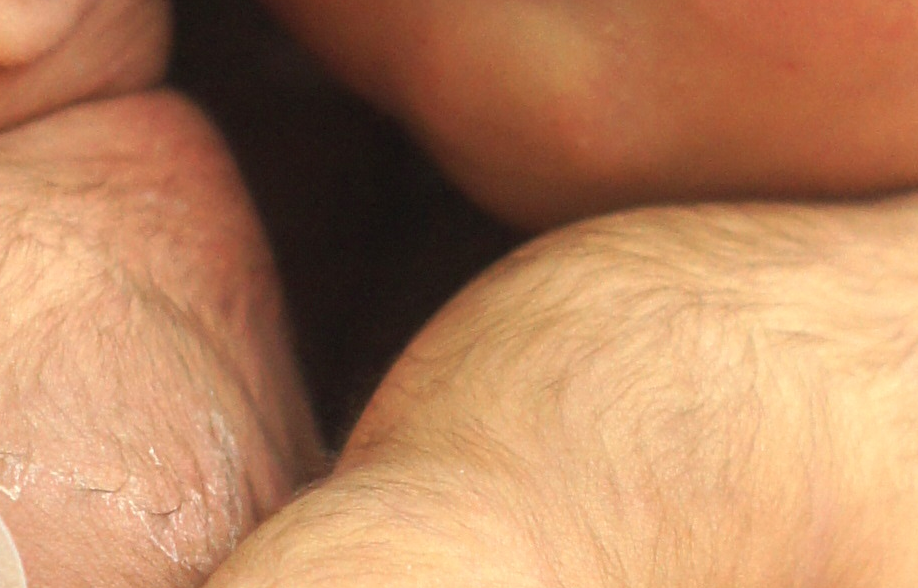Lanugo
Editor-In-Chief: Prab R Tumpati, MD
Obesity, Sleep & Internal medicine
Founder, WikiMD Wellnesspedia &
W8MD medical weight loss NYC and sleep center NYC
| Lanugo | |
|---|---|

| |
| Synonyms | |
| Pronounce | N/A |
| Specialty | N/A |
| Symptoms | Fine, soft hair covering the body |
| Complications | N/A |
| Onset | Fetal development |
| Duration | Temporary |
| Types | N/A |
| Causes | Fetal development, anorexia nervosa |
| Risks | |
| Diagnosis | Physical examination |
| Differential diagnosis | Vellus hair, Terminal hair |
| Prevention | N/A |
| Treatment | None required, resolves naturally |
| Medication | N/A |
| Prognosis | N/A |
| Frequency | Common in newborns |
| Deaths | N/A |
Fine, soft hair covering the body of a fetus or newborn
Lanugo is a type of fine, soft, and usually unpigmented hair that covers the body of a fetus or newborn. It is the first type of hair to be produced by the fetal hair follicles and plays a crucial role in the development and protection of the fetus.
Development[edit | edit source]
Lanugo begins to develop on the fetus around the fourth or fifth month of gestation. It is typically shed before birth, around the seventh or eighth month of pregnancy, although some infants are born with lanugo still present. This hair is replaced by vellus hair, which is finer and less noticeable.
Function[edit | edit source]
The primary function of lanugo is to protect the delicate skin of the fetus. It helps to hold the vernix caseosa, a waxy substance that covers the skin of the fetus, in place. The vernix caseosa acts as a barrier, protecting the skin from the amniotic fluid and preventing it from becoming waterlogged. Lanugo also plays a role in regulating the temperature of the fetus. By trapping heat close to the skin, it helps to maintain a stable body temperature in the womb.
Postnatal Presence[edit | edit source]
In some cases, lanugo is still present at birth, especially in premature infants. It usually disappears within a few weeks after birth as the infant's body hair matures into vellus hair. In rare cases, lanugo can persist longer, but it is generally not a cause for concern.
Lanugo in Adults[edit | edit source]
While lanugo is primarily associated with fetal development, it can also appear in adults under certain conditions. For example, individuals with anorexia nervosa may develop lanugo as a physiological response to severe weight loss and malnutrition. The growth of lanugo in these cases is thought to be a mechanism to conserve body heat.
See also[edit | edit source]
Transform your life with W8MD's budget GLP1 injections from $125
W8MD offers a medical weight loss program NYC and a clinic to lose weight in Philadelphia. Our W8MD's physician supervised medical weight loss centers in NYC provides expert medical guidance, and offers telemedicine options for convenience.
Why choose W8MD?
- Comprehensive care with FDA-approved weight loss medications including:
- loss injections in NYC both generic and brand names:
- weight loss medications including Phentermine, Qsymia, Diethylpropion etc.
- Accept most insurances for visits or discounted self pay cost.
- Generic weight loss injections starting from just $125.00 for the starting dose
- In person weight loss NYC and telemedicine medical weight loss options in New York city available
- Budget GLP1 weight loss injections in NYC starting from $125.00 biweekly with insurance!
Book Your Appointment
Start your NYC weight loss journey today at our NYC medical weight loss, and Philadelphia medical weight loss Call (718)946-5500 for NY and 215 676 2334 for PA
Search WikiMD
Ad.Tired of being Overweight? Try W8MD's NYC physician weight loss.
Semaglutide (Ozempic / Wegovy and Tirzepatide (Mounjaro / Zepbound) available. Call 718 946 5500.
Advertise on WikiMD
|
WikiMD's Wellness Encyclopedia |
| Let Food Be Thy Medicine Medicine Thy Food - Hippocrates |
Translate this page: - East Asian
中文,
日本,
한국어,
South Asian
हिन्दी,
தமிழ்,
తెలుగు,
Urdu,
ಕನ್ನಡ,
Southeast Asian
Indonesian,
Vietnamese,
Thai,
မြန်မာဘာသာ,
বাংলা
European
español,
Deutsch,
français,
Greek,
português do Brasil,
polski,
română,
русский,
Nederlands,
norsk,
svenska,
suomi,
Italian
Middle Eastern & African
عربى,
Turkish,
Persian,
Hebrew,
Afrikaans,
isiZulu,
Kiswahili,
Other
Bulgarian,
Hungarian,
Czech,
Swedish,
മലയാളം,
मराठी,
ਪੰਜਾਬੀ,
ગુજરાતી,
Portuguese,
Ukrainian
Medical Disclaimer: WikiMD is not a substitute for professional medical advice. The information on WikiMD is provided as an information resource only, may be incorrect, outdated or misleading, and is not to be used or relied on for any diagnostic or treatment purposes. Please consult your health care provider before making any healthcare decisions or for guidance about a specific medical condition. WikiMD expressly disclaims responsibility, and shall have no liability, for any damages, loss, injury, or liability whatsoever suffered as a result of your reliance on the information contained in this site. By visiting this site you agree to the foregoing terms and conditions, which may from time to time be changed or supplemented by WikiMD. If you do not agree to the foregoing terms and conditions, you should not enter or use this site. See full disclaimer.
Credits:Most images are courtesy of Wikimedia commons, and templates, categories Wikipedia, licensed under CC BY SA or similar.
Contributors: Kondreddy Naveen, Prab R. Tumpati, MD



